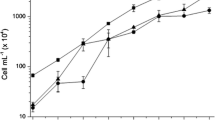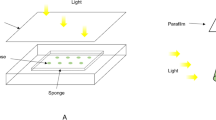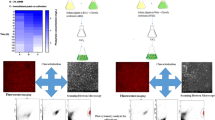Abstract
Owing to their extensive application, copper oxide nanoparticles (CuO NPs) has become common components in wastewater that arrives at wastewater treatment plants. Immobilization of microalgae and bacteria cells in alginate beads has been proposed as a potential tool for tertiary wastewater treatment processes to prevent the negative effect of biotic stress on immobilized microorganisms. Nonetheless, the effect of the emerging CuO NP contaminants on microalgae-bacteria interaction has not been evaluated. Thus, the aim of this study was to assess the effect of CuO NPs (1, 10, and 100 ppm) on the growth and metabolism of the microalga Scenedesmus sp. immobilized alone and concomitantly with the bacterium Azospirillum brasilense. Low CuO NP concentrations (1 ppm) induced higher growth rates for both microorganisms, regardless of their immobilization status (an average increase of 117.9% for Scenedesmus sp. and 73% for A. brasilense). In addition, microalga-bacterium co-immobilization enhanced the growth of Scenedesmus sp. in the control group (without NPs: 2.95 ± 0.32 cells × 104 bead−1) and in the presence of low (1 ppm: 8.69 ± 3.19 cells × 104 bead−1) and high NP concentrations (100 ppm: 2.39 ± 1.03 cells × 104 bead−1) compared with microalgae immobilized alone (without NPs: 1.79 ± 0.48 cells × 104 bead−1; 1 ppm: 6.82 ± 1.54 cells × 104 bead−1; 100 ppm: 1.32 ± 0.27 cells × 104 bead−1). Moreover, the interaction between Scenedesmus sp. and A. brasilense in the presence of 1 ppm CuO allowed for higher protein and carbohydrate contents than did the other treatments. The negative effect of the CuO NPs on the growth of the microorganisms was only observed at the higher concentration (100 ppm) when the microorganisms were immobilized alone. These results demonstrate that the use of immobilized cells can prevent the negative effects of emerging contaminants such as CuO NPs on microalgal growth. Moreover, the microalgae-bacteria interaction in the presence of CuO NPs allowed for identifying microalgae biomasses with high contents of the metabolites of interest.






Similar content being viewed by others
Data availability
The authors confirm that the data supporting the findings of this study are available within the article.
References
Barbosa-Nuñez JA, Palacios OA, de-Bashan LE, Snell-Castro R, Corona-González RI, Choix FJ (2022) Active indole-3-acetic acid biosynthesis by the bacterium Azospirillum brasilense cultured under biogas atmosphere enables its beneficial association with microalgae. J Appl Microbiol 132:3650-3663
Bashan Y, Trejo A, de-Bashan LE (2011) Development of two culture media for mass cultivation of Azospirillum spp. and for production of inoculants to enhance plant growth. Biol Fertil Soils 47:963-969
Cervantes-Avilés P, Keller AA (2021) Incidence of metal-based nanoparticles in the conventional wastewater treatment process. Water Res 189:116603
Chen X, Zhang C, Tan L, Wang J (2018) Toxicity of Cu nanoparticles on three species of marine microalgae. Environ Pollut 236:454–461
Chitemerere TA, Mukanganyama S (2014) Evaluation of cell membrane integrity as a potential antimicrobial target for plant products. BMC Complement Altern Med 14:278
Choix FJ, Ochoa-Becerra MA, Hsie-Lo M, Mondragón-Cortez P, Méndez-Acosta HO (2018) High biomass production and CO2 fixation from biogas by Chlorella and Scenedesmus microalgae using tequila vinasses as culture medium. J Appl Phycol 30:2247–2258
Choix FJ, Palacios OA, Contreras CA, Espinoza-Hicks JC, Mondragón-Cortez P, Torres JR (2023) Growth and metabolism enhancement in microalgae co-cultured in suspension with the bacterium Azospirillum brasilense under heterotrophic condition. J Appl Phycol 35:57–71
Chrzanowski TH, Crotty RD, Hubbard JG, Welch RP (1984) Applicability of fluorescein diacetate method of detecting active bacteria in freshwater. Microb Ecol 10:179–185
Covarrubias SA, de-Bashan LE, Moreno M, Bashan Y (2012) Alginate beads provide a beneficial physical barrier against native microorganisms in wastewater treated with immobilized bacteria and microalgae. Appl Microbiol Biotechnol 93:2669-2680
Cruz I, Bashan Y, Hernández-Carmona G, de-Bashan LE (2013) Biological deterioration of alginate beads containing immobilized microalgae and bacteria during tertiary wastewater treatment. Appl Microbiol Biotechnol 97:9847-9858
Dao G, Wang S, Wang X, Chen Z, Wu Y, Wu G, Lu Y, Liu S, Hu H (2020) Enhanced Scenedesmus sp. growth in response to gibberellin secretion by symbiotic bacteria. Sci Total Environ 740:140099
de-Bashan LE, Antoun H, Bashan Y (2008) Involved of Indole-3-Acetic Acid produced by the growth-promoting bacterium Azospirillum spp. in promoting growth of Chlorella vulgaris. J Phycol 44:938-947
de-Bashan LE, Hernandez JP, Morey T, Bashan Y (2004) Microalgae growth-promoting bacteria as “helpers” for microalgae: A novel approach for removing ammonium and phosphorous for municipal wastewater. Water Res 38:466-474
Ekanayake SA, Godakumbura PI (2021) Synthesis of a dual-functional nanofertilizer by embedding ZnO and CuO nanoparticles on an-alginate-based hydrogel. ACS Omega 6:26262
Du J, Fu L, Li H, Xu S, Zhou Q, Tang J (2019) The potential hazards and ecotoxicity of CuO nanoparticles: An overview. Toxin Rev 40:460–472
Fazelian N, Movafeghi A, Yousefzadi M, Rahimzadeh M (2019) Cytotoxic impacts of CuO nanoparticles on the marine microalgae Nannochloropsis oculata. Environ Sci Pollut Res 26:17499–17511
Gonzalez LE, Cañizares RO, Baena S (1997) Efficiency of ammonia and phosphorous removal from a colombian agroindustrial wastewater by the microalgae Chlorella vulgaris and Scenedesmus dimorphus. Bioresour Technol 60:259–262
Ji X, Cheng J, Gong D, Zhao X, Qi Y, Su Y, Ma W (2018) The effect of NaCl stress on photosynthetic efficiency and lipid production in freshwater microalga-Scenedesmus obliquus XJ002. Sci Total Environ 633:593–599
Jośko I, Oleszczuk P, Dobrzyńska J, Futa B, Joniec J, Dobrowolski R (2019) Long-term effect of ZnO and CuO nanoparticles on soil microbial community in different types of soils. Geoderma 352:204–212
Kamnev AA, Tugarova AV, Antonyuk LP, Tarantilis PA, Polissiou MG, Gardiner PHE (2005) Effects on heavy metals on plant-associated rhizobacteria: Comparison of endophytic and non-endophytic strains of Azospirillum brasilense. J Trace Elem Med Biol 19:91–95
Li X, Liu J, Tian J, Pan Z, Chen Y, Ming F, Wang R, Wang L, Zhou H, Li J, Tan Z (2023) Co-cultivation of microalgae-activated sludge for municipal wastewater treatment: Exploring the performance, microbial co-occurrence patterns, microbiota dynamics and function during the startup stage. Biorescour Technol 374:128733
Liang SXT, Wong LS, Antony-Dhanapal ACT, Djearamane S (2020) Toxicity of metals and metallic nanoparticles on nutritional properties of microalgae. Water Air Soil Pollut 231:52
Lopez BR, Palacios OA, Bashan Y, Hernández-Sandoval FE, de-Bashan LE (2019) Riboflavin and lumichrome exuded by the bacterium Azospirillum brasilense promote growth and changes in metabolites in Chlorella sorokiniana under autotrophic conditions. Algal Res 44:101696
Lopez BR, Bashan Y, Trejo A, de-Bashan LE (2013) Amendment of degraded desert soil with wastewater debris containing immobilized Chlorella sorokiniana and Azospirillum brasilense significantly modifies soil bacterial community structure, diversity, and richness. Biol Fert Soils 49:1053-1063
Markus AA, Parsons JR, Roex EWM, de Voogt P, Laane RWPM (2016) Modeling the transport of engineering metallic nanoparticles in the river Rhine. Water Res 91:214–224
Miao L, Wang C, Hou J, Wang P, Ao Y, Li Y, Yao Y, Lv B, Yang Y, You G, Xu Y, Gu Q (2017) Response of wastewater biofilm to CuO nanoparticle exposure in terms of extracellular polymeric substances and microbial community structure. Sci Total Environ 579:588–597
Oh-Hama T, Miyachi S (1992) Chlorella. In: Borowitzka MA, Borowitzka LJ (eds) Micro-algal Biotechnology. Cambridge University Press, Cambridge, pp 3–26
Otero-González L, Field JA, Sierra-Alvarez R (2014) Inhibition of anaerobic wastewater treatment after long-term exposure to low levels of CuO nanoparticles. Water Res 58:160–168
Pagnussat LA, do Nascimento M, Marinoche G, Gonorazky G, Sanchez-Rizza L, Creus C, Curatti L (2023) Azospirillum baldaniorum improves acclimation, lipid productivity and oxidative response of a microalga under salt stress. Algal Res 74:103192
Pagnussat LA, Marinoche G, Curatti L, Creus C (2020) Auxin-dependent alleviation of oxidative stress and growth promotion of Scenedesmus obliquus C1S by Azospirillum brasilense. Algal Res 47:101839
Palacios OA, Choix FJ, Bashan Y, de-Bashan LE (2016) Influence of tryptophan and indol-3-acetic acid on starch accumulation in the synthetic mutualism Chlorella sorokiniana-Azospirillum brasilense system under heterotrophic conditions. Res Microbiol 167:367-379
Palacios OA, León-Vega RA, López BR, de-Bashan LE, Choix FJ, Cuevas-Rodríguez G (2023) Microalgae-bacteria interactions mitigates the adverse effects on microalgae produced by ZnO nanoparticles. Algal Res 74:103198
Palacios OA, López BR, de-Bashan LE (2022) Microalga Growth-Promoting Bacteria (MGPB): A formal term proposed for beneficial bacteria involved in microalgal-bacterial interactions. Algal Res 61:102585
Pedroso-Melegari S, Perreault F, Ribeiro-Costa RH, Popovic R, Matias WG (2013) Evaluation of toxicity and oxidative stress induced by copper oxide nanoparticles in the green algae Chlamydomonas reinhardtii. Aquat Toxicol 142–143:431–440
Peng H, de-Bashan LE, Higgins BT (2021) Azospirillum brasilense reduces oxidative stress in the green microalgae Chlorella sorokiniana under different stressors. J Biotechnol 325:179-185
Romero N, Visentini FF, Márquez VE, Santiago LG, Castro GR, Gagneten AM (2020) Physiological and morphological responses of green microalgae Chlorella vulgaris to silver nanoparticles. Environ Res 189:109857
Rosero-Chasoy G, Rodríguez-Jasso RM, Aguilar CN, Buitrón G, Chairez I, Ruiz HA (2021) Microbial co-culturing strategies for the production high value compounds, a reliable framework towards sustainable biorefinery implementation – an overview. Bioresour Technol 321:124458
Saravanakumar K, Sathiyaseelan A, Mariadoss AVA, Xiaowen H, Wang M-H (2020) Physical and bioactivities of biopolymeric films incorporated with cellulose, sodium alginate and copper oxide nanoparticles for food packaging application. Int J Biol Macromol 153:207–214
Shang H, Guo H, Ma C, Li C, Chefetz B, Polubesova T, Xing B (2019) Maize (Zea mays L.) root exudates modify the surface chemistry of CuO nanoparticles: Altered aggregation, dissolution and toxicity. Sci Total Environ 690:502–510
Shoman N, Solomonova E, Akimov A, Rylkova O (2023) Responses of microalgae Isochrysis galbana Parke, 1949, on copper oxide nanoparticles and copper iones impact under short- and long-term cultivation. Water Air Soil Pollut 234:382
Sibhatu AK, Weldegebrieal GK, Sagadevan S, Tran NN, Hessel V (2022) Photocatalytic activity of CuO nanoparticles for organic and inorganic pollutants removal in wastewater remediation. Chemosphere 300:134623
Trejo A, de-Bashan LE, Hartmann A, Hernandez J-P, Rothbller M, Schmid M, Bashan Y (2012) Recycling waste debris of immobilized microalgae and plant growth-promoting bacteria from wastewater treatment as a resource to improve fertility of eroded desert soil. Environ Exp Bot 75:65–73
Vargas-Estrada L, Torres-Arellano S, Longoria A, Arias DM, Okoye PU, Sebastian PJ (2020) Role of nanoparticles on microalgal cultivation: A review. Fuel 280:118598
Wang L, Huang X, Sun W, Too HZ, Carrasco-Laserna AK, Yau-Li SF (2020) A global metabolomic insight into the oxidative stress and membrane damage of copper oxide nanoparticles and microparticles on microalga Chlorella vulgaris. Environ Pollut 258:113647
Wollmann F, Dietze S, Ackermann J-U, Bley T, Walther T, Steingroewer J, Krujatz F (2019) Microalgae wastewater treatment: biological and technological approaches. Eng Life Sci 19:860–871
You X, Xu N, Yang X, Sun W (2021) Pollutants affect algae-bacteria interactions: A critical review. Environ Pollut 276:116723
Zhang B, Li W, Guo Y, Zhang Z, Shi W, Cui F, Lens PNL, Tay JH (2020) Microalgal-bacterial consortia: From interspecies interactions to biotechnological applications. Renew Sustain Energy Rev 118:109563
Acknowledgements
At Drs. José Roberto Ramos Ibarra, Martín Flores Martinez, and Sergio Oliva León by Scanning Electron Microscopy (SEM) service of CUCEI-UdG.
Funding
This work was supported by Programa para el Desarrollo Profesional Docente – Prodep OF-20–8581.
Author information
Authors and Affiliations
Contributions
Karen A. Alonso performed the experiments; Francisco J. Choix discussed experimental procedures for metabolites analysis and critically revised the final manuscript; Guadalupe V. Nevarez-Moorillón participate in the discussion of the results and statistical analysis; Oskar A. Palacios discussed the experimental setting, supervised the experiments, wrote the draft, and critically revised the article for intellectual content. All the authors read and approved the manuscript.
Corresponding author
Ethics declarations
Competing interests
The authors have no relevant financial or non-financial interest to disclose.
Additional information
Publisher's Note
Springer Nature remains neutral with regard to jurisdictional claims in published maps and institutional affiliations.
Rights and permissions
Springer Nature or its licensor (e.g. a society or other partner) holds exclusive rights to this article under a publishing agreement with the author(s) or other rightsholder(s); author self-archiving of the accepted manuscript version of this article is solely governed by the terms of such publishing agreement and applicable law.
About this article
Cite this article
Alonso, K.A., Choix, F.J., Nevarez-Moorillón, G.V. et al. Microalgae-bacteria interaction in alginate beads prevents the negative effect of copper oxide nanoparticles on the growth and metabolism of Scenedesmus sp.. J Appl Phycol 36, 155–166 (2024). https://doi.org/10.1007/s10811-023-03150-5
Received:
Revised:
Accepted:
Published:
Issue Date:
DOI: https://doi.org/10.1007/s10811-023-03150-5




